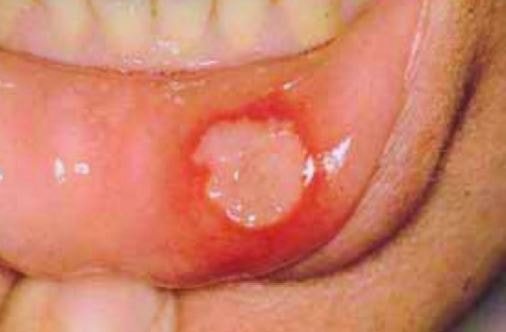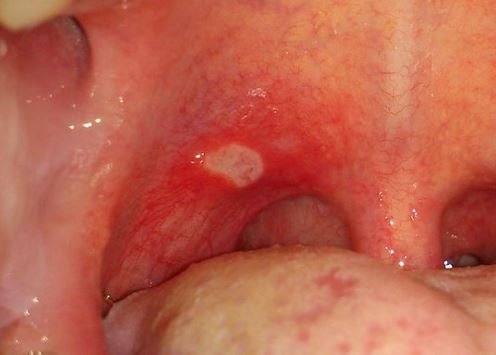Aphthous Ulcers
What are aphthous ulcers?
Aphthous ulcers are typical ulceration, develops on the mucous membranes. These ulcers are recurrent in nature.

The different alternative names for aphthous ulcers are:
- Recurrent aphthous stomatitis (RAS)
- Aphthae,
- Aphthosis,
- Aphthous stomatitis and
- Canker sores
Inside the mouth, specifically the area surrounded by the lips, on the cheeks or beneath the tongue, where mucous membranes are not attached with bones are affected with aphthous ulcers. Therefore, aphthous ulcers are mostly restricted in the oral cavity, though similar types of ulcer are also found in genital organ of the male and female.
Some significant characteristics make the aphthous ulcers contrasting with other types of ulcer, though there are always chances of wrong diagnosis with other types of mouth ulcers. Usually recurrent aphthous ulcers (RAS) do not cause any serious health issue, but creates some minor trouble. But in some cases, RAS causes a significant health hazardous. (1,2)
Symptoms
Depending upon the types of aphthous ulcers, their sign and symptoms vary. Therefore sign and symptoms can be well explained by an illustration of the types of aphthous ulcers.
Types of aphthous ulcers
There are three types of aphthous ulcers, this classification is based on appearance, severity and duration of the affected periods
Minor aphthous ulcers
These are most frequent clinical findings among all the other types of aphthous ulcers. Almost out of ten, eight cases are minor aphthous ulcers. The diameter of the round or oval shaped ulcer not exceed 10mm. The coloration of the ulcer is pale yellow and the surrounded area may become inflamed and red. At a time, the number of ulcer can vary from one to five.
The usual distressing period is lasted for 7 to 10 days and then they are subsided by their own way, without creating any scar marks. This type of ulcers is not too much painful or less discomfort is associated.
Major aphthous ulcers
These do not frequently occur and can express in 1: 10 ratio of finding cases. The size of the ulcer is mostly 10 mm or more in diameter. They do not appear in a group, one or two can appear inside the mouth at a time. The duration of the affected period varies from 15 days to several months and scare marks are prominent after disappearing the ulcer. They are causing severe pain and eating becomes difficult.
Herpetiform ulcers
These are also not frequently developing ulcers and finding of cases are 1 in 10. They are tiny sized similar to pinhead and the diameter of ulcer is 1-2 mm. Usually they appear in a group (may be 100 ulcers at a time) and some may form irregular shaped clusters. The complete curing of the ulcers may take over two months, though the healing may start after one week. The term ‘Herpetiform’ does not relate with herpes or the herpes virus.
Aphthous ulcers can reoccur at any age, but initial occurrence is usually in 10 years or 40 years of age. The recurrence may vary from days to months or even years between each attack of ulcers. With increasing age (at elderly individual) the recurrence of ulcers becomes less frequent. In various cases the ulcers eventually bring to a halt and do not reoccur. Some individual experience a burning sensation in the affect part(s) of the oral cavity for a day or so prior to the occurrence of the ulcer. (3,4,5)
Pictures



Causes
The different predisposing factors which cause aphthous ulcers are as follows:
Genetics
Usually individual has the family history or the past history of more serious ulcer development is commonly associated with aphthous ulcers. Research data support that HLA antigens have an association with RAS. These associations precisely fluctuate with ethnic and racial genesis.
Trauma
Any traumatic injury in the oral cavity, including sharp or spiky tooth, dental treatments, anesthetic injections in the oral cavity, and hurting during brushing the teeth may prompt to the development of recurrent aphthous ulceration.
Drugs
Certain drugs influence the development of the aphthous ulceration, which include captopril, phenobarbital, nicorandil, sodium hypochloride, phenindione, diclofenac, propionic acid, and piroxicam.
Hematinic deficiency
Iron, vitamin B12, and folic acid are the most important hematinic factors. A deficiency of these factors may associated with poor dietary habit or genetic factors influence the onset of aphthous ulcers.
Certain diseases
Gluten sensitive enteropathy (GSE), inflammatory bowel disease (IBS), Crohn’s disease and ulcerative colitis have associated with aphthous ulcers formation.
Stress
It has been found that most individual unknowingly perform parafunctional practices like cheek or lip biting during stress and this habit can cause trauma and may influence to ulceration formation, so stress indirectly emphasizes RAS.
Tobacco
Smoking of cigarette or smokeless tobacco product has negative associations with RAS, as tobacco increase the keratinized layer inside mouth and thicken cover coated the mucous membrane, which provide protective barrier from traumatic injury and microbial attacks.
Research also reveals that Nicotine can provide protective action, as they stimulates adrenal secretions and reduce the inflammatory agents secretion like interleukins 1 and 6 and tumor necrosis factor alpha (TNF-α). (5)
Treatment
The available treatment options for aphthous ulcers can be divided into following categories:
Antibiotic medications
The prescribed antibiotics can be given via local or systemic route depending upon the severity of the condition. Two widely used antibiotics are tetracycline and minocycline. The dose tetracycline 1000 mg, which prescribe into four divided doses per day, whereas the dose of minocycline is 200 mg, which prescribe into two divided dose per day.
The therapy is usually taken as “swish and swallow” or “swish and spit” mode. Both the antibiotics have serious side effects in children and pregnant women. Therefore, doctors should take very much care about the need of the antibiotic therapy and before prescribing the drugs, possible side effects should be discussed with patient representative.
Anti-inflammatory agents
Different effective anti-inflammatory agents are available, which speed up the ulcer healing. Triamcinolone 0.1% paste can be applied locally on the ulcers and this will provide a protective coating over the ulcers. The application of the medication at an early stage is provide better results and quick healing. In severe cases, dexamethasone elixir, 0.5 mg per 5 ml is used as douse and expectorated.
Immune modulators
Thalidomide 200 mg OD to BD dose for 3-8 weeks can provide faster healing. This medication is mostly prescribed for AIDS patient, as their immune system becomes poorly functioning. New clinical trial investigates that Amlexanox 5 % paste has effective to treat aphthous ulcers.
Other agents
For symptomatic relief like reduction of pain can be possible by applying the local anesthetics or OTC benzocaine preparations. Systemic administration of NSAIDS like acetaminophen may offer some analgesic effect in case of intolerable pain.
Alternative agents
- Alternative methods are available to treat aphthous ulcers, and speed up healing:
- Zinc gluconate lozenges
- Multivitamins and essential amino acids include vitamin C, vitamin B complex and lysine.
- Sage and chamomile mouthwash, etc. (6)
References
- Crispian Scully (2015); aphthous ulcers; retrieve from: http://emedicine.medscape.com/article/867080-overview#a6
- DermNet NZ (2015); aphthous ulcers; retrieve from: http://www.dermnetnz.org/site-age-specific/aphthae.html
- Dr Tim Kenny (2013); aphthous mouth ulcers; retrieve from: http://patient.info/health/aphthous-mouth-ulcers
- David F. Murchison (2014); Recurrent Aphthous Stomatitis; retrieve from:
http://www.msdmanuals.com/professional/dental-disorders/symptoms-of-dental-and-oral-disorders/recurrent-aphthous-stomatitis - L Preeti, KT Magesh,1 K Rajkumar, and Raghavendhar Karthik (2011); Recurrent aphthous stomatitis; retrieve from: http://www.ncbi.nlm.nih.gov/pmc/articles/PMC3227248/
- DAVID R. MCBRIDE (2000); Management of Aphthous Ulcers; retrieve from: http://www.aafp.org/afp/2000/0701/p149.html
